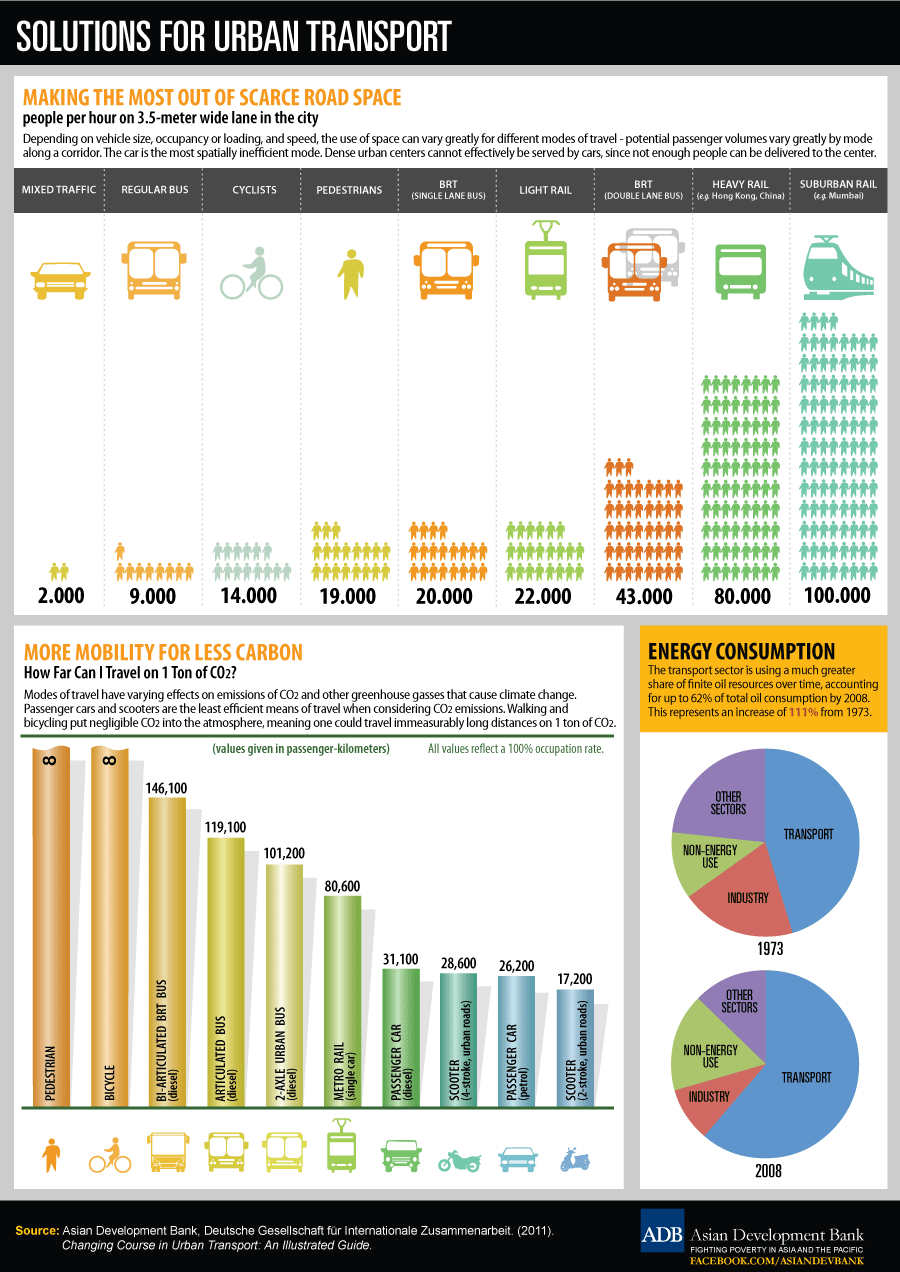
Solutions for Urban Transport
SOLUTIONS FOR URBAN TRANSPORT MAKING THE MOST OUT OF SCARCE ROAD SPACE people per hour on 3.5-meter wide lane in the city Depending on vehide size, occupancy or loading, and speed, the use of space can vary greatly for different modes of travel - potential passenger volumes vary greatly by mode along a corridor. The car is the most spatially inefficient mode. Dense urban centers cannot effectively be served by cars, since not enough people can be delivered to the center. HEAVY RAIL SUBURBAN RAIL (eg Mumbai) BRT BRT MIXED TRAFFIC REGULAR BUS CYCLISTS PEDESTRIANS LIGHT RAIL (DOUBLE LANE BUS) : (eg Hong Kong, China) : (SINGLE LANE BUS) 2.000 9.000 14.000 19.000 20.000 22.000 43.000 80.000 100.000 ENERGY CONSUMPTION MORE MOBILITY FOR LESS CARBON How Far Can I Travel on 1 Ton of CO2? Modes of travel have varying effects on emissions of CO2 and other greenhouse gasses that cause climate change. Passenger cars and scooters are the least efficient means of travel when considering CO2 emissions. Walking and bicycling put negligible COz into the atmosphere, meaning one could travel immeasurably long distances on 1 ton of CO2. The transport sector is using a much greater share of finite oil resources over time, accounting for up to 62% of total oil consumption by 2008. This represents an increase of 111% from 1973. (values given passenger-kilometers) All values reflect a 100% occupation rate. 146,100 OTHER SECTORS 119,100 TRANSPORT 101,200 NON-ENERGY USE 80,600 INDUSTRY 1973 31,100 28,600 26,200 17,200 OTHER SECTORS NON-ENERGY USE TRANSPORT INDUSTRY 2008 Source: Asian Development Bank, Deutsche Gesellschaft für Internationale Zusammenarbeit. (2011). ADB Asian Development Bank FIGHTING POVERTY IN ASIA AND THE PACIFIC Changing Course in Urban Transport: An Ilustrated Guide. FACEBOOK.COM/ASIANDEVBANK PEDESTRIAN BICYCLE BI-ARTICULATED BRI BUS ARTICULATED BUS diese Z:AXLE URBAN BUS (diesel) IE METRO RAIL PASSENGER CAR (diesel) (4-stroke, urban roads) 8 PASSENGER CAR (2-stroke, urban roads) 8 SOLUTIONS FOR URBAN TRANSPORT MAKING THE MOST OUT OF SCARCE ROAD SPACE people per hour on 3.5-meter wide lane in the city Depending on vehide size, occupancy or loading, and speed, the use of space can vary greatly for different modes of travel - potential passenger volumes vary greatly by mode along a corridor. The car is the most spatially inefficient mode. Dense urban centers cannot effectively be served by cars, since not enough people can be delivered to the center. HEAVY RAIL SUBURBAN RAIL (eg Mumbai) BRT BRT MIXED TRAFFIC REGULAR BUS CYCLISTS PEDESTRIANS LIGHT RAIL (DOUBLE LANE BUS) : (eg Hong Kong, China) : (SINGLE LANE BUS) 2.000 9.000 14.000 19.000 20.000 22.000 43.000 80.000 100.000 ENERGY CONSUMPTION MORE MOBILITY FOR LESS CARBON How Far Can I Travel on 1 Ton of CO2? Modes of travel have varying effects on emissions of CO2 and other greenhouse gasses that cause climate change. Passenger cars and scooters are the least efficient means of travel when considering CO2 emissions. Walking and bicycling put negligible COz into the atmosphere, meaning one could travel immeasurably long distances on 1 ton of CO2. The transport sector is using a much greater share of finite oil resources over time, accounting for up to 62% of total oil consumption by 2008. This represents an increase of 111% from 1973. (values given passenger-kilometers) All values reflect a 100% occupation rate. 146,100 OTHER SECTORS 119,100 TRANSPORT 101,200 NON-ENERGY USE 80,600 INDUSTRY 1973 31,100 28,600 26,200 17,200 OTHER SECTORS NON-ENERGY USE TRANSPORT INDUSTRY 2008 Source: Asian Development Bank, Deutsche Gesellschaft für Internationale Zusammenarbeit. (2011). ADB Asian Development Bank FIGHTING POVERTY IN ASIA AND THE PACIFIC Changing Course in Urban Transport: An Ilustrated Guide. FACEBOOK.COM/ASIANDEVBANK PEDESTRIAN BICYCLE BI-ARTICULATED BRI BUS ARTICULATED BUS diese Z:AXLE URBAN BUS (diesel) IE METRO RAIL PASSENGER CAR (diesel) (4-stroke, urban roads) 8 PASSENGER CAR (2-stroke, urban roads) 8
Solutions for Urban Transport
Source
Unknown. Add a sourceCategory
TransportationGet a Quote








